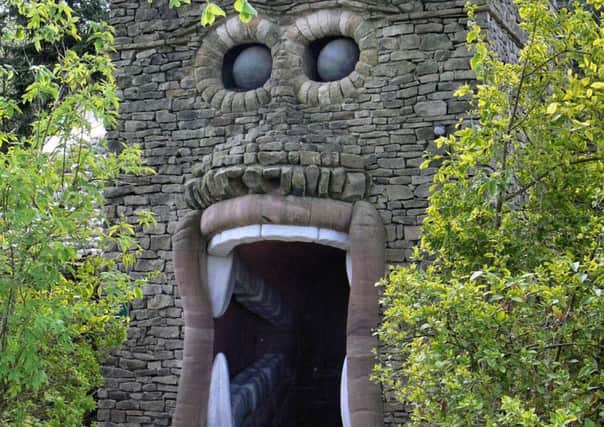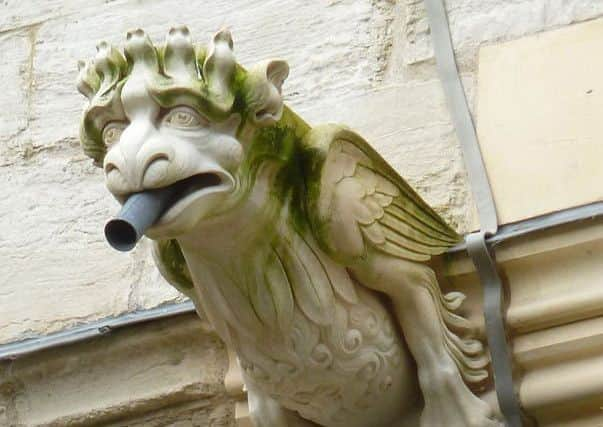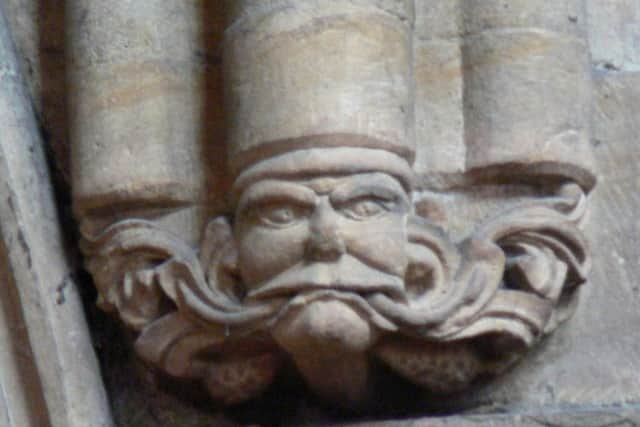Civic Society column with David Winpenny


In architecture, buildings have faces, too – though we might refer to them as facades or elevations.
You might also say that the face that a building presents to the world has its own character.
Advertisement
Hide AdAdvertisement
Hide AdBut faces can also be literal – carved or painted on to a structure or perhaps in mosaic. It is a very human trait to want to place images of ourselves on the places we inhabit.


A decade ago archaeologists announced that the oldest-known image of a human face had been found in a cave near Angoulême in France.
It dates from around 27,000 years ago.
No previous prehistoric art has been discovered showing a face; the only other representations of humans, among the many animal species that were the usual subjects of cave art, were stick men with spears and bows.
Things went quiet, as far as we know, until the times of the Egyptians and their contemporaries, when we start to get what we might consider to be proper portraits; the Greeks and Romans carried on the tradition, too, sometimes depicting ordinary people as well as the ruling classes.


Advertisement
Hide AdAdvertisement
Hide AdReligious art – for the pagans, depicting gods and goddesses, for Christians showing Christ and the saints – was displayed inside temples and churches. Outside, statues and bas reliefs would depict them, too.
But as we get into the Middle Ages, western architecture branches out into depiction of more everyday faces, especially in corbels and in gargoyles.
Corbels, the projecting bosses at the top of a wall below the roof, are sometimes confused with gargoyles, but they are usually smaller and don’t have the waterspout that, before the days of drainpipes, carried rainwater clear of the walls.
Corbels can be amusing and playful, carved with funny faces and sometimes with animal heads.


Advertisement
Hide AdAdvertisement
Hide AdGargoyles, usually more elaborate, come in many forms. There are dragons and griffins, giants and elves, hideous men and witch-like women.
They are usually the result of the mason being given his freedom to come up with a design that he enjoys.
Gargoyles are often much more interesting than figures of saints and angels; it’s another case of the devil having all the best tunes.
But the gargoyles weren’t just there to amuse the masons and the passers-by; they served a secondary purpose besides their water-shedding.


Advertisement
Hide AdAdvertisement
Hide AdThey were there to ward off evil, on the (perhaps doubtful) grounds that malign forces, seeing something grotesque, would flee in terror.
Such faces have the same function as statues on the top of castles and gateways – like Micklegate Bar in York or the entrance to Alnwick Castle.
The idea was that enemies would see these figures outlined against the sky and assume that the city or the castle was guarded by ever-vigilant troops.
Such statues are known to architectural historians as ‘apotropaic figures’, from the Greek meaning ‘to turn away evil.’
Advertisement
Hide AdAdvertisement
Hide AdThere are many faces inside medieval buildings, too. Look carefully at the walls and vaults of any church or castle and you’ll quickly spot them.
In Ripon Cathedral, for example, there are quite large faces hidden in the vault of the south choir aisle – some still with painted eyes – and by the arch through the screen there are tiny faces carved on the pillars.
And there is a cluster of faces on one of the pillars on the north side of the choir, where they hide an adjustment made by the builders.
There’s also at least one of the famous ‘Green Men’ in the Cathedral – on the north wall of the nave near the west end.
Advertisement
Hide AdAdvertisement
Hide AdGreen Men, with foliage growing out of their mouths, are some of the most persistent and curious of the faces depicted by the medieval masons.
Their exact meaning is unknown; they may have developed as a fertility symbol – or they, too, may have been apotropaic.
With the enlightenment that came with the Renaissance, architecture didn’t lose its liking for faces.
They appear frequently, sometimes as ugly or cheerful masks on keystones of doors and windows, sometimes on plasterwork ceilings, sometimes carved on fireplaces. They often appear, too, on 18th-Century bridges.
Advertisement
Hide AdAdvertisement
Hide AdNineteenth-century public buildings were often adorned with faces. Sometimes they can represent classical figures – personifications of rivers, depicting an old man with long, flowing hair and beard, were popular.
Or the faces may have been of important people of the time – there are keystones depicting Disraeli and Gladstone, for instance – or architects.
In the 20th and 21st centuries there has been, perhaps, less emphasis on faces in architecture – perhaps we are too used to seeing depictions of faces everywhere we look through advertising, film and television. But faces sometimes crop up – like the face that is the entrance to The Forbidden Corner near Middleham.
Here the architect Malcolm Tempest has built on an Italian tradition of making the whole façade of the building into a face.
Advertisement
Hide AdAdvertisement
Hide AdThe most famous example is in the 16th-Century garden at Bomarzo in Italy, where a wide-mouthed face with staring eyes and flared nostrils hides a table for picnics within it.
There’s a similar, contemporary face at the Villa Guisti in Verona, and a modern version at the Swarovski Crystal works near Innsbruck dating from 1995. So watch out for the faces on the buildings all around us – they’re watching out for you!